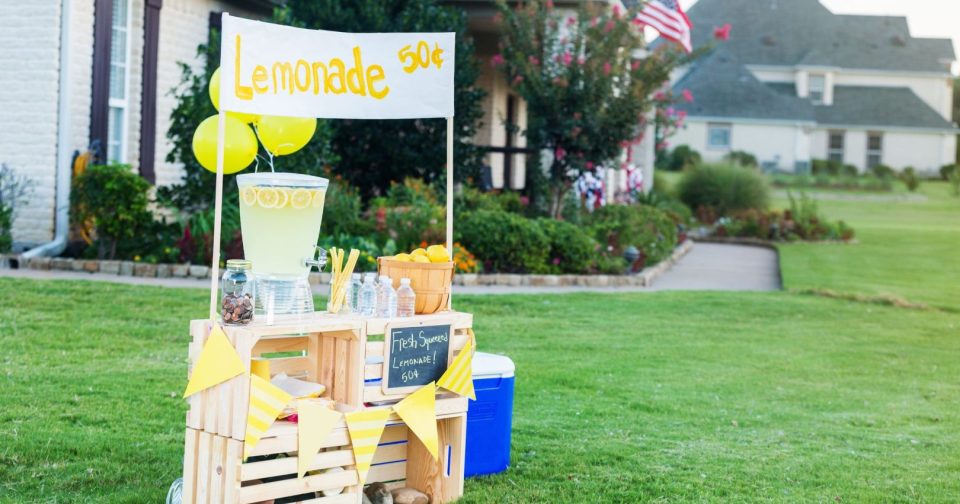Imagine a neighborhood lemonade stand ran by two little kids on the front lawn of one of their homes. Each morning the children wake up and begin working to make their fresh-squeezed, ice-cold, lemonade. They use only the finest lemons, sugar, and bottled water to make their product which has more or less given them a monopoly on lemonade stands in the neighborhood through their exceptional quality and lack of competition. It costs them approximately 50 cents per cup to make, and they sell a cup for $1 earning 50 cents per cup sold. During the first week of their stand, they were able to average 20 cups sold per day, earning them a profit of $10 per day or $70 for the week.
The parents of the children decide that to make more profit they will use tap water, the generic store brand sugar, and replace half of the lemons used with powder mix from the store. Their new cost is only 25 cents per cup, and they still sell at the $1 price earning them a profit of 75 cents per cup sold, a 50% increase in profits per unit. The children were able to sell an average of 10 glasses per day for a profit of $7.50 or $52.50 for the week.
1-Why did their revenue go down when their percentage of profit increased?
2-Could their decline in quality lead to an opening in the market for another lemonade stand to break their monopoly?
After seeing this reduction in profits, the parents decide that to sell more lemonade they would close down the only other entrance to the neighborhood so that everyone exiting or entering would have to pass by their children’s stand increasing the number of potential customers. After one week of keeping the road closed and forcing every traveler to pass their stand, the children were able to sell an average of 15 glasses per day for a profit of $11.25 per day or $78.75 for the week.
Unsatisfied that they were only able to generate an additional $8.75 of profit during the week, the parents decided to call more members of the family to help generate revenue. The parents, uncles, aunts, nieces, nephews and so on all poured into town to help. The parents decided that they would set up checkpoints on the roadway in front of their house to force people to stop and purchase a glass. After one week of forcing everyone who passed to buy the $1 glass, they were able to sell 50 glasses per day for a profit of $37.50 per day or $262.50 per week.
3-Why did they suddenly earn 5 times the money this week as they had in any other week so far?
The parents, as ecstatic as they were, realized that $262.50 per week would not be enough to fund the entire family, who is out of work to aid in the stand, so they bought a 10’x10’ space in the local park directly in front of the subway where two of the younger cousins would also sell lemonade. Knowing that they will earn more than enough money using their tactic at the park they have no concerns about not being able to pay back the loans. The family decides to split into two groups, one at the house and one at the park, but everything else remains the same.
On day one at the park, a family member was in the middle of telling a passerby that because he passed through this area he had willingly consented to purchase the lemonade when he was told “But I am allergic to lemons. I couldn’t drink lemonade.” to which he replied “Whether you drink it or pour it out is irrelevant, you must buy it. If you do not wish to use it we are happy to keep it for you, so you are not inconvenienced by having to carry it.”
After the first week with both locations, the children were able to sell an average of 150 glasses of lemonade per day for a profit of $112.50 per day or $787.50 profit per week.
4-Does the passerby not having a desire for the item, yet having to pay for the item compare to any other aspect of “civilized” society?
Realizing that the children could sell anything and still receive the $1 payment the parents decide to cut out most of the cost and stop selling lemonade to instead sell plastic cups of water. After cutting out the lemons, lemonade powder, and sugar the cost per cup fell to 3 cents per customer, for an average profit of 97 cents. With no option but to pay for the cup of water or suffer, every passerby at both locations continues to pay $1. They sold the same amount of water as they had lemonade in the first week leading to an average profit of $145.50 per day or $1,018.50 profit per week.
5-What are the passersby paying for?
6-Why did their profits increase as a result of this decline in quality while they fell before?
7-Is there a difference between forcing someone with the threat of violence to purchase lemonade and forcing them with the threat of violence to purchase a road, a school, a museum, a library, an arts program, the largest military the world has ever seen, laws they do not agree with or any other number of things the United States Government does on “our” behalf.
8-What group(s) does the family members represent?
9-What group(s) do the children represent?
10-What group(s) do the passersby represent?

